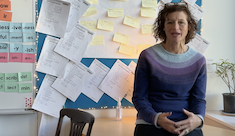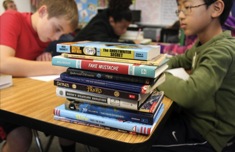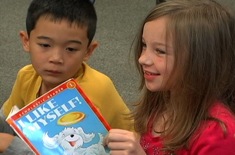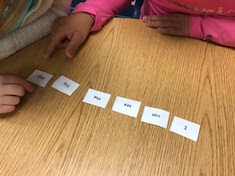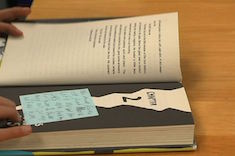Reading Strategies
Are your students buried in post-its? Oversharing with those text-to-self connections? Parroting back comprehension tips but rarely applying them when they are actually reading? Our contributors sort through what works with strategy instruction, and have wise advice for avoiding superficial approaches to developing comprehension skills.
Latest Content
Background Knowledge: More than Just Facts
Although background knowledge may feel like an “old concept,” Leigh Anne Eck offers fresh and important considerations to lift students’ ability to comprehend complex texts.
Reading Nonfiction: A Digital Anchor Chart
Tammy Mulligan uses a digital anchor chart to hold several steps to guide students while reading nonfiction text. Students tape a copy of the printed digital anchor chart into their notebooks so they have easy access to it while reading in the classroom or at home.
Latest and Greatest Ways to Show Independent Reading Is Valued
Even as the pressure to add more whole-class reads and articles with focused reading lessons closes in around us with pressure from administrators and school boards, Tara Barnett and Kate Mills are committed to finding ways to get books into students’ hands and show how much they value reading. Here are some of their best tips for keeping the choice in reading—as well as the love of reading—alive.
Writing About Reading: A Search for Authenticity
In this powerful essay, Leigh Anne Eck challenged herself to read a complex text and discover the authenticity of writing about reading. She transferred her experience to create meaningful opportunities for her students as they write about their own independent reading.
Quick and Easy Reading Responses
Tara Barnett and Kate Mills offer three ways for students to write a quick and meaningful response inspired by their independent reading.
Morning Message Series: When and How
It’s not always easy to hold on to effective instructional routines and find ways to embrace new initiatives and mandates. In the first installment of a morning message series, Ruth Metcalfe addresses the issue of time.
My Teaching Toolbox (Part 2)
Dana Murphy reminds us that having a teaching toolbox makes planning efficient and effective. In this second installment of a two-part series, Dana offers two additional approaches to delivering strong reading instruction.
Managing Your Students’ Independent Work During Guided Reading
Are you ready to ditch small-group instruction because it seems too difficult for students to work independently? Lisa Mazinas compiled a helpful chart to problem solve common classroom issues and support student independence.
Moving Beyond Asking Questions
Dana Murphy comes to a lesson about asking questions in a curriculum resource and realizes it is not what her students need. She has designed a lesson to make asking questions more meaningful and useful for her students.
Literacy Tool Kits
Inspired by tool kits with math manipulatives, Jen Court created literacy tool kits with the help of her first-grade students. These tool kits grow and change across the year and according to student needs, and they help students “touch their thinking” and become more independent readers and writers.
Read Aloud Magic
Jen Court reminds us of the power of reading aloud to students and pushes us to remember the importance of planning to use books to engage students and hone teaching points.
Spoiler Alert: You Can Start Big to Go Small (Macbeth in One Class Period)
Gretchen Schroeder confesses her fast-paced approach to sharing Macbeth with her high school students. Starting with the big picture of the story and then drilling down into specific scenes for skill practice not only accomplished the goals for the unit, but also freed up more time and space for other curriculum needs.
Cut-Apart Sentences in Small-Group Reading
Ruth Metcalfe candidly shares the way she tackles the transfer of reading skills with her small group by using cut-apart sentences.
What Do You Meme: Logical Fallacies
Gretchen Schroeder teaches her high school students how to notice and combat logical fallacies, a much needed skill due to the fact that most of her students use memes as their primary news source.
Examining Book Choices with Awareness of Bias
Bitsy Parks takes into account her consideration of implicit biases and examines her classroom library and read aloud choices with urgency and excitement.
Digital Reading Strategies
Mandy Robek reflects on her identity as a digital and print reader and offers strategies to support students reading digital texts.
Lessons and Minilessons: What’s the Difference?
What’s the difference between a lesson and a minilesson? Christy Rush-Levine finds that flexibility is just as important as length in making minilessons work well.
Pairing Video Clips with Text: The Great Depression
Mark Levine has his middle school students “closely read” paired videos as well as texts to ponder the value and accuracy of different historical sources.
The Freewrite Pause
Mark Levine finds his middle school students need more time to digest learning from brief articles. Freewriting provides the perfect pause for promoting more reflection and insight.
Reading and Thinking Aloud in Middle School
Mark Levine combines reading and thinking aloud in a minilesson to help his middle school students grapple with complex texts.
The Third (or More) Time Is the Charm
Gretchen Schroeder finds helping her students see the value in rereading poems is all about helping them pay close attention to imagery.
Student Notes: Slow Down and Think
Fifth grader Orion uses sticky notes to make questions and predictions at the end of each chapter.
Student Notes: Reading for Writing
Reagan, a fifth grader in Franki Sibberson's class, explains how she uses sticky notes to flag examples of writer's craft she could use in her own writing.
Student Notes: Reminders for Later
We continue our video series from Franki Sibberson's class of fifth graders explaining how they take notes while reading. Sarah marks important elements early in the mystery she is reading, so she can easily refer to them later.
Splashing Around to Find Themes
Christy Rush-Levine moves from emphasizing theme to teaching strategies for understanding text, and finds it’s a much better way to get her eighth graders to grapple with theme in natural, organic ways.
Student Notes: Keeping Track of Many Characters
Tre uses lots of sticky notes to sort through and keep track of characters in a book with a whole classroom full of personalities.
Student Notes: Experimenting with Two Strategies
What do student notes from independent reading look like when students have free choice? In this video series, fifth graders from Franki Sibberson's class explain their notetaking strategies. We start with Ally, who tries out two different strategies to figure out which one will help her the most.
Conferring: Establishing a Setting in a Novel
In this week's video, Aimee Buckner has a quick conference with a fourth grader about ways to solve a dilemma — how to figure out the setting in a historical fiction novel when there are no pictures.
Revising Thinking Through Multiple Readings
We’ve all had that student — the one who blurts out a misreading of a text, only to have classmates agree with the analysis. Christy Rush-Levine explains how she uses “first-, second-, and third-draft readings” to help her middle school students develop stronger comprehension skills.
Fostering More Rereading in Classrooms
Stella Villalba explains why rereading is especially useful for young English language learners, and shares some simple strategies for integrating more rereading strategies into reading and writing workshops
Browse Content By
Type
Category
- Assessment Tools
- Big Fresh Archives
- Booklists
- Choice Numeracy
- Classroom Design
- Common Core
- Community Building
- Conferring
- Content Literacy
- Digital Literacy
- English Language Learners
- Equity
- Family Relations
- Free Samples
- Guiding Groups
- Leadership
- Literacy Coaches
- Mentor Texts
- Minilessons
- New Teacher Mentors
- Podcasts
- Poetry
- Quote Collections
- Reading Strategies
- Self Care
- Struggling and Striving Learners
- Talking and Listening
- Teacher Study Groups
- Teaching Reading
- Teaching Writing
- Word Study and Vocabulary
Author
- Melissa Quimby
- Nawal Qarooni
- Gwen Blumberg
- Julie Cox
- The Lead Learners
- Hannah Tills
- Josie Stewart
- Ruth Metcalfe
- Mallory Messenger
- Becca Burk
- Jodie Bailey
- Vivian Chen
- Mary Brower
- Tiffany Abbott Fuller
- Stephanie Affinito
- Ruth Ayres
- Leigh Anne Eck
- Heather Fisher
- Shari Frost
- Julie Johnson
- Suzy Kaback
- Gigi McAllister
- Shirl McPhillips
- Melanie Meehan
- Cathy Mere
- Debbie Miller
- Tara Barnett and Kate Mills
- Tammy Mulligan
- Dana Murphy
- Bitsy Parks
- David Pittman
- Brenda Power
- Heather Rader
- Matt Renwick
- Mandy Robek
- Christy Rush-Levine
- Gretchen Schroeder
- Jen Schwanke
- Brian Sepe
- Katherine Sokolowski
- Stella Villalba
- Jennifer Vincent
Grade Level
Choice Literacy Membership
Articles
Get full access to all Choice Literacy article content
Videos
Get full access to all Choice Literacy video content
Courses
Access Choice Literacy course curriculum and training


